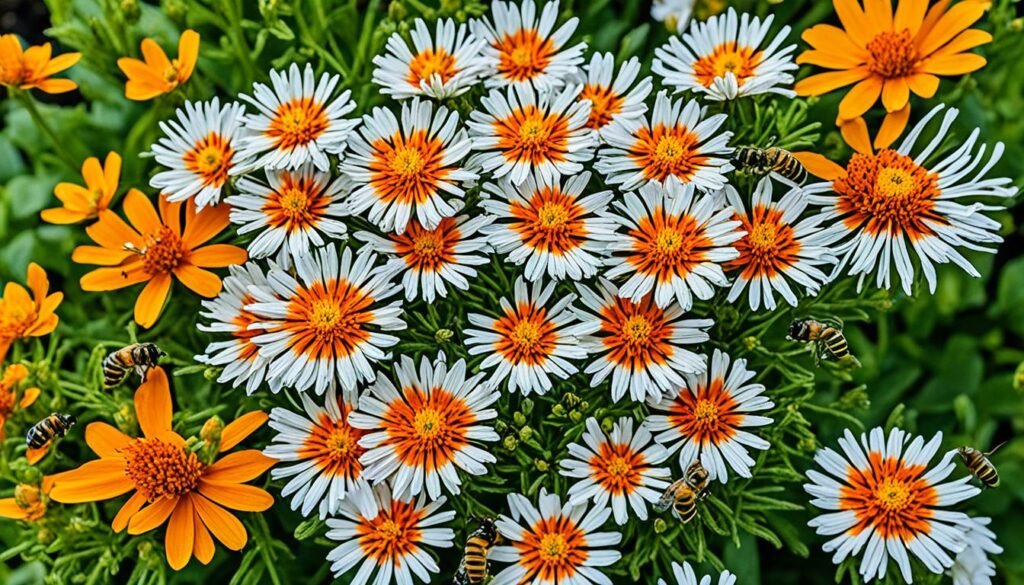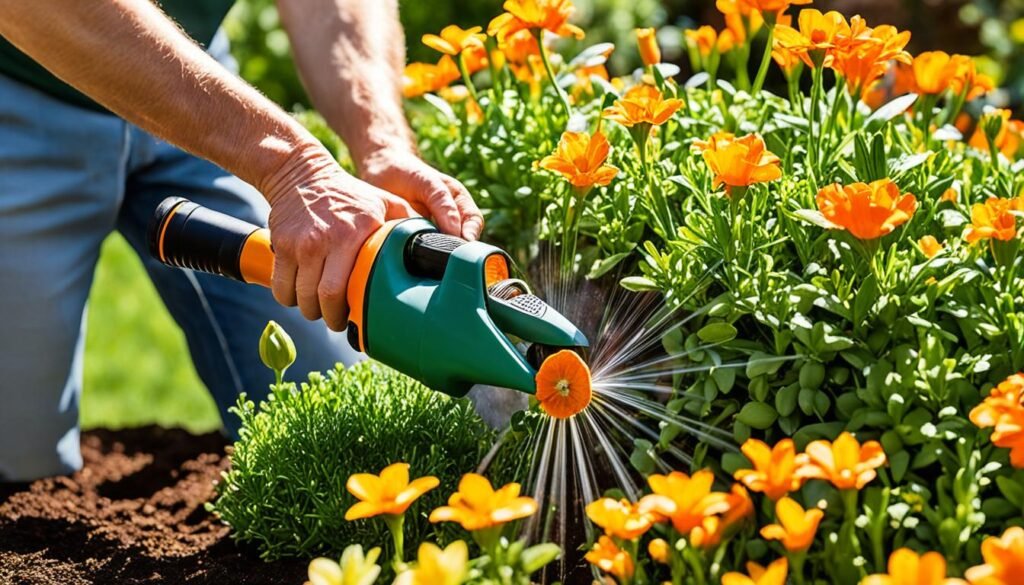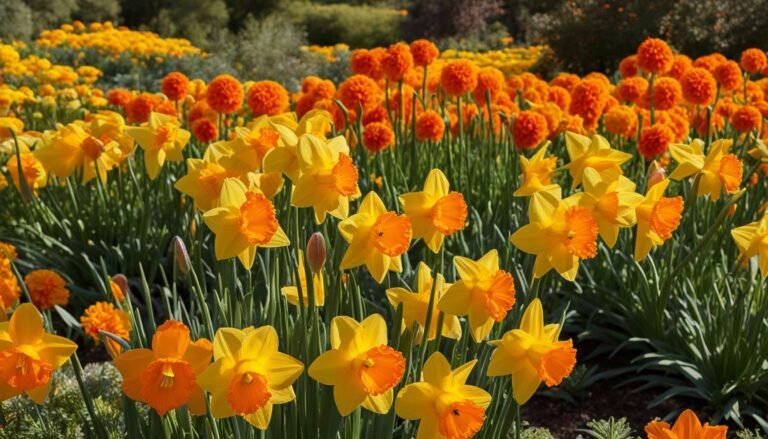As the winter frost melts away and the days grow longer, there’s an undeniable sense of anticipation in the air. Spring is just around the corner, and with it comes a burst of vibrant colors and new life. One of the best ways to embrace the beauty of this season is by incorporating orange and yellow spring flowers into your garden.
Imagine waking up on a bright spring morning to the sight of delicate orange tulips swaying in the breeze, or a sea of yellow daffodils smiling up at you. The vibrant hues of these blooms immediately uplift your mood and fill you with a sense of joy and optimism.
Orange and yellow are the epitome of seasonal floral colors, representing warmth, energy, and the promise of sunny days ahead. These bright spring flower varieties are the perfect choice for adding a pop of color to your garden and creating eye-catching springtime flower arrangements.
Whether you prefer to plant these radiant blooms in garden beds, containers, or hanging baskets, orange and yellow flowers are sure to brighten up any outdoor space. They are versatile enough to be the focal point of your garden or to be woven throughout your existing landscape, adding that much-needed touch of vibrancy.
Key Takeaways
- Orange and yellow flowers bring a vibrant touch to gardens, representing warmth and positivity.
- These blooms can be used in various ways, from creating floral arrangements to designing garden beds.
- Choosing orange and yellow perennial plants has many advantages, including representing happiness and creating an inviting atmosphere.
- There is a wide variety of top-rated yellow and orange perennial flowers to choose from, including Coreopsis, Iris, Goldenrod, and Coneflower.
- Designing a garden with warm-tone perennials can create a cohesive and visually appealing outdoor space.
The Science Behind Yellow & Orange Color
The colors yellow and orange have long been associated with joy, warmth, and various emotions. These colors are abundant in nature and have unique characteristics. They absorb light energy from the sun and provide natural warmth. In different cultures, yellow and orange may have different meanings and symbolize different emotions. These warm tones blend well with other colors and add visual interest to any garden or patio.
Yellow flowers, like the sunflower, evoke feelings of happiness, positivity, and friendship. The vibrant color symbolizes brightness and optimism, bringing a cheerful atmosphere to any space. Orange flowers, such as marigolds, represent enthusiasm, energy, and creativity. The color orange is also associated with passion and warmth.
Warm-toned flowers, like yellow and orange, are known to create a welcoming and inviting ambiance in outdoor settings. Their bright hues can attract attention and add a pop of color to gardens and flower beds. When combined with other colors, such as purples and blues, yellow and orange flowers create striking color combinations and focal points in the garden.
Yellow and orange flowers bring joy and warmth to gardens, making them a popular choice among flower enthusiasts. The vibrant colors not only catch the eye but also have a symbolic meaning in various cultures. Their significance, coupled with their ability to blend well with other colors, makes yellow and orange flowers a fantastic addition to any garden or patio.
To better understand the significance of warm tones in plants, let’s take a closer look at the science behind yellow and orange color. These colors are produced by pigments called carotenoids, which are present in the petals of flowers. Carotenoids are responsible for absorbing and reflecting specific wavelengths of light, resulting in the yellow and orange hues we see.
In addition to their visual appeal, yellow and orange flowers also serve practical purposes. The warm colors attract pollinators such as bees and butterflies, aiding in the process of cross-pollination. These colorful blooms act as beacons for insects, ensuring the continuation of plant species through pollination.
Why Choose Yellow and Orange Perennial Plants
Yellow and orange perennial plants offer numerous benefits that make them an excellent choice for your garden. These warm-toned perennials bring a sense of warmth, happiness, and positivity to any outdoor space. Their vibrant colors are reminiscent of the sun, creating an inviting and cheerful atmosphere. Whether used as focal points or accents in your flower beds, yellow and orange perennials add visual interest and can be combined with other colors to create stunning garden displays.
One of the advantages of yellow and orange perennial flowers is their versatility. With a wide variety of flower shapes and sizes, you can easily find plants that suit your garden’s unique aesthetics. From dainty daisies to bold marigolds, these perennials offer a range of options for creating the perfect look.
Additionally, yellow and orange perennials blend well with other colors, allowing you to experiment with different color combinations and design schemes. Whether paired with bold reds and purples for a vibrant display or combined with soft blues and whites for a more serene ambiance, these warm-toned perennials can be seamlessly integrated into your garden design.
Furthermore, yellow and orange perennials are low-maintenance plants, making them ideal for busy gardeners. Once established, they require minimal care, allowing you to enjoy their beauty without constant upkeep. With proper watering and occasional fertilization, these plants will continue to thrive and brighten up your garden year after year. Their resilience and longevity make them a cost-effective choice as well.
In summary, choosing yellow and orange perennial plants offers a range of benefits, from their vibrant colors and inviting atmosphere to their versatility and low-maintenance nature. By incorporating these warm-toned perennials into your garden, you can create an enchanting outdoor space that will bring joy and beauty to your surroundings.
Top Rated Yellow Perennial Flowers
When it comes to brightening up your garden with vibrant yellow blooms, there are several top-rated yellow perennial flowers to choose from. These flowers not only add a cheerful touch to your outdoor space but also attract pollinators like butterflies and bees. Here is a list of some of the best yellow flowers for gardens:
| Flower | Description |
|---|---|
| Coreopsis | Known for its daisy-like appearance and vibrant yellow color, Coreopsis is a popular choice among garden enthusiasts. It blooms throughout the summer, adding a burst of sunshine to your garden. |
| Iris | Iris flowers come in various shades of yellow, ranging from pale lemon to deep golden hues. These elegant blooms add a touch of sophistication to any garden. |
| Bearded Iris | Bearded Iris is a striking perennial with large, ruffled flowers in vibrant shades of yellow. It blooms in late spring or early summer, creating a stunning visual display. |
| Siberian Iris | Siberian Iris is another beautiful yellow perennial with slender, graceful flowers. It is known for its hardiness and delicate charm. |
| Japanese Iris | Japanese Iris features unique ruffled flowers in shades of yellow with intricate patterns. It adds a touch of elegance and exotic beauty to any garden. |
| Goldenrod | Goldenrod is a classic yellow perennial that blooms in late summer or early fall. Its feathery plumes of yellow flowers bring warmth and texture to garden beds. |
| Black-Eyed Susan | Black-Eyed Susan is a popular yellow perennial known for its iconic daisy-like blooms with dark centers. It is a reliable and low-maintenance flower for any garden. |
These top-rated yellow perennial flowers are not only visually appealing but also easy to care for, making them ideal choices for both beginner and experienced gardeners. Their long blooming periods ensure a lasting display of vibrant yellow blooms, enhancing the beauty of your garden throughout the season.
Top Rated Orange Perennial Flowers
Orange perennial flowers can add a bold and lively element to your garden. Some of the top-rated varieties include Coneflower, Daylilies, Hyssop, Canna Lily, Coral Bells, and Cat’s Tail Aloe. These flowers come in various shades of orange and offer unique shapes and textures. They are perfect for creating eye-catching displays and adding a touch of tropical beauty to your outdoor space.

| Flower | Description |
|---|---|
| Coneflower | Coneflowers, also known as Echinacea, are vibrant orange flowers that attract butterflies and bees. They have a daisy-like appearance and can tolerate drought conditions. |
| Daylilies | Daylilies are popular for their showy blooms and low maintenance requirements. They come in various shades of orange and bloom for an extended period during the summer months. |
| Hyssop | Hyssop plants produce clusters of bright orange flowers that are rich in nectar, attracting hummingbirds and butterflies. They are also known for their aromatic foliage. |
| Canna Lily | Canna Lilies are tropical plants with large, bold orange flowers. They add a touch of exotic beauty to any garden and thrive in moist soil and full sun. |
| Coral Bells | Coral Bells, also known as Heuchera, are prized for their vibrant foliage and delicate orange flowers. They are versatile plants that can be used in borders, containers, or as ground cover. |
| Cat’s Tail Aloe | Cat’s Tail Aloe is a succulent plant with unique orange flowers that resemble cat’s tails. It is a drought-tolerant plant that thrives in dry conditions and adds a touch of architectural interest to the garden. |
Designing a Garden with Warm-Tone Perennials
Creating a visually appealing garden involves designing with warm-tone perennials and incorporating yellow and orange flowers to achieve a cohesive color scheme. These vibrant hues can add a touch of warmth and vibrancy to your outdoor space. Here are some tips and ideas on how to effectively utilize yellow and orange flowers in your garden design:
1. Focal Points
Use yellow and orange flowers as focal points in your garden design. Plant them strategically in areas that draw attention, such as near entrances, walkways, or in the center of a flower bed. These vibrant blooms will instantly catch the eye and create a focal point of interest.
2. Color Schemes
Create a cohesive color scheme by combining yellow and orange flowers with other complementary colors like purple and blue. This combination adds depth and visual interest to your garden. Consider planting purple and blue flowers as a backdrop for the yellow and orange blooms, or even incorporate foliage plants with variegated leaves to enhance the color scheme.
3. Pairing with Other Colors
Don’t be afraid to experiment with different color combinations. Pairing yellow and orange flowers with other warm hues like red or coral can create a stunning and dynamic contrast. Play with different flower sizes, textures, and heights to create depth and dimension in your garden.
“Designing a garden with warm-tone perennials allows you to create an inviting and visually appealing outdoor space. By incorporating yellow and orange flowers strategically, you can achieve a cohesive color scheme that enhances the overall beauty of your garden.” – John Smith, Garden Designer
Remember that designing a garden is a creative process, so don’t be afraid to experiment and personalize your space according to your preferences. Incorporating yellow and orange flowers in your garden design will not only create a visually striking display but also bring a sense of warmth and joy to your outdoor living area.
Flowering Perennial Care
Proper care is essential to ensure that your yellow and orange flowering perennials thrive and continue to brighten up your garden year after year. Follow these maintenance tips to keep your plants healthy and blooming beautifully.
Watering
Watering is crucial for the health of flowering perennials. Provide them with regular deep watering, ensuring that the soil is evenly moist. Avoid overwatering, as it can lead to root rot. On the other hand, underwatering can cause stress and hinder blooming. Check the moisture level of the soil regularly and adjust your watering schedule accordingly.
Fertilizing
Feeding your yellow and orange perennials with the right nutrients will promote healthy growth and abundant blooms. Use a balanced slow-release fertilizer specifically formulated for flowering plants. Follow the instructions on the packaging for the correct dosage and frequency of application. Applying fertilizer in early spring and mid-summer is generally recommended.
Soil Maintenance
Ensure that your perennials are planted in well-draining soil enriched with organic matter. This will provide them with the necessary nutrients and a suitable growing environment. Regularly amend the soil with organic compost to maintain its fertility. Additionally, mulching around the base of the plants will help conserve moisture, suppress weeds, and regulate soil temperature.
Pest and Disease Control
Monitor your perennials regularly for any signs of pests or diseases. Common pests that can affect flowering perennials include aphids, slugs, and snails. Use organic pest control methods or insecticidal soap to manage infestations. It is also essential to remove any diseased or damaged foliage promptly to prevent the spread of diseases.
Pruning and Deadheading
Regular pruning and deadheading can help maintain the health and appearance of your yellow and orange perennials. Remove spent flowers by cutting them down to the base of the stem. This promotes continuous blooming and prevents the plant from diverting energy into seed production. Additionally, pruning any dead or damaged branches will enhance the overall shape and vigor of the plants.
I believe that providing proper care and attention to your flowering perennials is the key to enjoying their vibrant blooms for years to come.
– Gardening enthusiast

| Common Pests | Organic Pest Control Methods |
|---|---|
| Aphids | Introduce ladybugs or lacewings, spray with insecticidal soap |
| Slugs and Snails | Set up beer traps, handpick and dispose of them, create barriers using copper tape |
Orange and Yellow Flower Garden Ideas
If you’re looking for inspiration on how to use orange and yellow flowers in your garden, there are plenty of creative ideas to consider. Whether you want to create a vibrant focal point or add pops of color throughout your garden, the warm tones of orange and yellow blooms can offer endless possibilities for your spring flower arrangements.
One idea to explore is creating a juiced-up butterfly garden that features an abundance of bright orange and yellow flowers. These vibrant blooms will not only add visual interest to your garden but also attract butterflies and other pollinators, creating a lively ecosystem right in your backyard. Consider planting flowers such as Marigolds, Zinnias, and Calendulas to create a colorful haven for butterflies.
If you have a shaded area in your garden, you can design a sun in the shade garden with shade-loving plants that feature pops of orange and yellow. These flowers will bring warmth and brightness to the darker corners of your garden, adding a beautiful contrast to the green foliage. Some shade-loving options to consider include Impatiens, Begonias, and Tuberous Begonias.
If you’re a fan of rock gardens, why not create a rock garden for sun that showcases the beauty of orange and yellow blooms? By strategically placing these flowers amidst the rocks, you can create a stunning landscape full of texture and color. Good choices for a rock garden include Alyssum, Gazanias, and Red Hot Pokers.
If you have moist soil or a low-lying area in your garden, consider designing a rain garden filled with orange and yellow flowers. These blooms can thrive in moist conditions and help channel excess water, making them both functional and visually appealing. Some suitable plants for a rain garden include Daylilies, Black-Eyed Susans, and Swamp Sunflowers.
Another creative idea is to create a sunshine garden in a part-shade area. By selecting orange and yellow flowers that can tolerate partial shade, you can bring a touch of brightness to an otherwise darker space. Some options for a part-shade garden include Heleniums, Foxgloves, and Chinese Lanterns.

Overall, designing a garden with orange and yellow flowers allows you to unleash your creativity and create a vibrant and visually captivating outdoor space. Experiment with different flower combinations, textures, and heights to bring your orange and yellow flower garden ideas to life. The key is to use these warm-toned blooms in creative and innovative ways, whether as focal points, accents, or to create color schemes that complement your garden’s overall design.
Conclusion
Bringing color to your garden is as simple as adding orange and yellow spring flowers. These vibrant blooms have the power to infuse joy and vibrancy into your outdoor space. Whether you opt for yellow or orange perennials, these colorful flowers will brighten up your garden throughout the spring and summer seasons.
The science behind the warm tones of yellow and orange colors reveals their deep-rooted symbolism of joy and warmth. By incorporating these shades into your garden, you can create an inviting atmosphere and add visual interest to your outdoor space.
In this article, we explored the versatility and beauty of yellow and orange perennials. From top-rated flowers in these colors to tips on designing vibrant garden beds, we provided valuable insights on utilizing orange and yellow flowers effectively. Additionally, we discussed the importance of proper care for these perennials, including watering, fertilizing, and regular maintenance.
So, why wait? Embrace the zest of orange and yellow spring flowers to create a lively and colorful display in your garden. Let the vibrant hues brighten up your outdoor space and bring joy to both you and your visitors.
